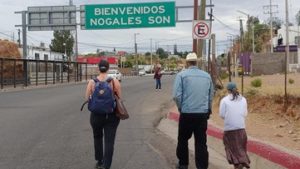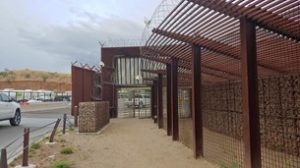Blog Post: Law Enforcement Voices at the Border
May 28, 2021
Law Enforcement Immigration Task Force Blog
Law Enforcement Voices at the Border
According to data from Customs and Border Protection (CBP), over 178,000 immigrants were stopped trying to cross the U.S.-Mexico border in April. This 21-year high in monthly apprehensions was largely comprised of single adults, who are rapidly expelled under the pandemic-era Title 42 rule. Recidivism rates are also high, as Title 42 expulsions pose less penalties than traditional processing. Since March 2020, approximately 40% of those apprehended at the border have been repeat crossers, compared to just 7% in 2019. In March, CBP encountered 16,000 unaccompanied children (UACs) at the border — the highest number on record since the agency began collecting this data in 2010. This number decreased by 12% in April.
There have been concerns about crowding and inadequate conditions of border detention facilities, especially those that house children. In March, many UACs were held in CBP detention centers for over the legal limit of 72 hours, due to processing delays and lack of capacity in children’s shelters run by Health and Human Services.
Although the humanitarian situation at the border is cause for concern, the recent influx is not a threat to public safety as some proclaim. To get a better picture of the situation, we asked two LEITF members along the southern border to share their thoughts and experiences regarding the current influx of arriving migrants. Andy Harvey is the police chief in Pharr, TX, which is directly across from Reynosa, Mexico. David Hathaway is the sheriff in Santa Cruz County, AZ, which includes the Nogales Port of Entry.


*responses have been edited for length and clarity*
- How has your community responded to the reports of what is happening at the border?
Chief Harvey (Pharr, TX): There is an interesting dynamic here at the border. The media coverage tends to focus solely on showing undocumented immigrants crossing the border. This creates a perception that our cities and neighborhoods are being ‘invaded,’ and it is simply not the case. If you ask the locals here, they will more likely tell you the current situation does not impact their quality of life. Interestingly, the Rio Grande Valley is safe when comparing crime rates to other regions.
On the humanitarian side, we are fortunate to have compassionate non-profit organizations that are making a difference in the lives of those crossing the border with little to nothing. These organizations provide food, shelter, clothing, medical assistance and show true humanity to many that our federal government cannot do alone.
Sheriff Hathaway (Santa Cruz County, AZ): We don’t have a ‘migrant crisis’ at the border; we have an economic crisis. The ports of entry have been shut to tourist visa holders from Mexico for over 13 months. In Santa Cruz County, 90% of our businesses in the shopping district have been shut down and we are not sure if they will ever reopen. My county has the largest port of entry into Mexico from Arizona, so there is a lot of cross-border activity. We have an important relationship with Mexico culturally and economically, based on tourism, retail and wholesale merchants and the produce industry.
But this economic crisis impacts the entire country, not just border communities. During the winter, it is especially important to have our ports of entry open so we can keep supplies in stock for our northern climate. In a typical year, tourist visa holders from Mexico spend $55 million USD each day in the US economy. We are not seeing that spending anymore.
- What do you find most concerning about the situation?
Chief Harvey: What is most concerning about the border situation is the victimization that may be occurring within the groups brought over by criminal enterprises. We know these crimes, such as sexual assaults, will most likely not be reported due to fear and this is extremely disturbing.
Sheriff Hathaway: We’re putting pressure on people to get around the ports of entry. So many people talk about legal immigration and commerce and emphasize going through ports of entry legally. But the major ports of entry in my area are seriously understaffed and backed up. Trucks trying to come through with produce are waiting in lines for hours and the produce is spoiling before being able to come into the U.S. Even I have to wait for hours to come back into the U.S. because there is just not enough staffing at the ports of entry. We also don’t have enough immigration judges available. People are put into limbo for years waiting to be processed. In order to encourage legal immigration, legal asylum and legal commerce, we need to have adequate staffing and processing available.
- Is there a role for local law enforcement in finding/advocating for solutions to this challenge?
Chief Harvey: I sometimes feel our elected officials on both sides of the aisle are not listening to local law enforcement to truly understand the reality of what is occurring in our local communities and how their actions or inactions are affecting all of us. We (local government and communities) are the ones that deal with these challenges. Listening to those of us that live, work, and protect communities, to truly understand and make more informed decisions, is vital. We can add value if they are willing to seek to understand our important perspectives.
Sheriff Hathaway: I think our federal officials are uniformed on this situation. Everyone is assuming that there is a migrant crisis. I’ve tried to get the message out that there is not a migrant crisis. We have non-profits that are providing meals and housing to those that have crossed.
I was contacted by the head of the Arizona National Guard at the request of the Governor. The Governor offered to have troops come to my county to assist with the border. I turned down the offer. The national guard needs a sponsoring agency and I declined. Pima County Sheriff Nanos also declined, as did the police chief. Not only is there not a migrant crisis, but the optics of having the National Guard here would be very bad. It is a negative visual image on the border and makes it seem like it’s militarized. It’s not a war zone. We’ve already had a major economic shut down because of the coronavirus, but if you add troops to that, the imagery will discourage anyone from coming into our community for economic or cultural opportunities. All four border communities in Arizona, all four elected County Boards of Supervisors, sent a letter to the Governor saying that they did not want or need the National Guard for assistance.
- What do you think the Biden administration needs to do to address the influx at the border?
Chief Harvey: We (the U.S.) can have both a secure border and rational immigration reform without sacrificing one for the other. These go hand in hand and should be included in the same conversation. First, it seems the only ones benefitting from the current surge across the border are the criminal enterprises that are smuggling undocumented immigrants to the U.S. We must work with Mexico to counter these dangerous people and operations. Second, having a crystal-clear process for those seeking asylum that creates confidence in restoring humanity, hope, and order. Third, the immigration discussions should always be about people, not politics. Place partisan agendas aside and work together for the best interest of all.
Sheriff Hathaway: People have been talking about this for years. Federal officials don’t even know the current status of our visa and asylum programs. The law is unclear. We need industry leaders and local officials, law enforcement, chambers of commerce, to come together with immigration experts and elected officials to discuss. But it can’t be all talk. Someone with decision-making power needs to move forward.




